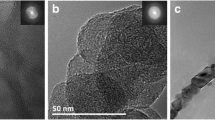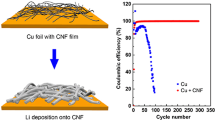Abstract
The inherently low electrical conductivity of TiO2-based electrodes as well as the high electrical resistance between an electrode and a current collector represents a major obstacle to their use as an anode for lithium ion batteries. In this study, we report on high-density TiO2 nanotubes (NTs) branched onto a carbon nanofiber (CNF) “tree” that provide a low resistance current path between the current collector and the TiO2 NTs. Compared to a TiO2 NT array grown directly on the current collector, the branched TiO2 NTs tree, coupled with the CNF electrode, exhibited ∼10 times higher areal energy density and excellent rate capability (discharge capacity of ∼150 mA·h·g−1 at a current density of 1,000 mA·g−1). Based on the detailed experimental results and associated theoretical analysis, we demonstrate that the introduction of CNFs with direct electric contact with the current collector enables a significant increase in areal capacity (mA·h·cm−2) as well as excellent rate capability.

Similar content being viewed by others
References
Bruce, P. G.; Scrosati, B.; Tarascon, J. M. Nanomaterials for rechargeable lithium batteries. Angew. Chem. Int. Edit. 2008, 47, 2930–2946.
Tarascon, J. M.; Armand, M. Issues and challenges facing rechargeable lithium batteries. Nature 2001, 414, 359–367.
Noailles, L. D.; Johnson, C. S.; Vaughey, J. T.; Thackeray, M. M. Lithium insertion into hollandite-type TiO2. J. Power Sources 1999, 81, 259–263.
Ohzuku, T.; Kodama, T.; Hirai, T. Electrochemistry of anatase titanium-dioxide in lithium nonaqueous cells. J. Power Sources 1985, 14, 153–166.
Li, J. R.; Tang, Z. L.; Zhang, Z. T. Preparation and novel lithium intercalation properties of titanium oxide nanotubes. Electrochem. Solid St. 2005, 8, A316–A319.
van de Krol, R.; Goossens, A.; Meulenkamp, E. A. In situ X-ray diffraction of lithium intercalation in nanostructured and thin film anatase TiO2. J. Electrochem. Soc. 1999, 146, 3150–3154.
Deng, D.; Kim, M. G.; Lee, J. Y.; Cho, J. Green energy storage materials: Nanostructured TiO2 and Sn-based anodes for lithium-ion batteries. Energ. Environ. Sci. 2009, 2, 818–837.
Kim, H.; Kim, M. G.; Cho, J. Unique structural changes of three-dimensionally ordered macroporous TiO2 electrode materials during electrochemical cycling. Adv. Energy Mater. 2012, 2, 1425–1432.
Wu, H. B.; Chen, J. S.; Hng, H. H.; Lou, X. W. Nanostructured metal oxide-based materials as advanced anodes for lithium-ion batteries. Nanoscale 2012, 4, 2526–2542.
Jiang, J.; Li, Y.; Liu, J.; Huang, X.; Yuan, C.; Lou, X. W. Recent advances in metal oxide-based electrode architecture design for electrochemical energy storage. Adv. Mater. 2012, 24, 5166–5180.
Wang, Z.; Lou, X. W. TiO2 Nanocages: Fast synthesis, interior functionalization and improved lithium storage properties. Adv. Mater. 2012, 24, 4124–4129.
Ryu, M. H.; Jung, K. N.; Shin, K. H.; Han, K. S.; Yoon, S. K. High performance N-doped mesoporous carbon decorated TiO2 nanofibers as anode materials for lithium-ion batteries. J. Phys. Chem. C 2013, 117, 8092–8098.
Wagemaker, M.; Kentgens, A. P. M.; Mulder, F. M. Equilibrium lithium transport between nanocrystalline phases in intercalated TiO2 anatase. Nature 2002, 418, 397–399.
Luo, Y. S.; Luo, J. S.; Jiang, J.; Zhou, W. W.; Yang, H. P.; Qi, X. Y.; Zhang, H.; Fan, H. J.; Yu, D. Y. W.; Li, C. M.; et al. Seed-assisted synthesis of highly ordered TiO2@α-Fe2O3 core/shell arrays on carbon textiles for lithium-ion battery applications. Energ. Environ. Sci. 2012, 5, 6559–6566.
Wang, D. H.; Choi, D. W.; Li, J.; Yang, Z. G.; Nie, Z. M.; Kou, R.; Hu, D. H.; Wang, C. M.; Saraf, L. V.; Zhang, J. G.; et al. Self-assembled TiO2-graphene hybrid nanostructures for enhanced Li-ion insertion. ACS Nano 2009, 3, 907–914.
Chen, J. S.; Liu, H.; Qiao, S. Z.; Lou, X. W. Carbon-supported ultra-thin anatase TiO2 nanosheets for fast reversible lithium storage. J. Mater. Chem. 2011, 21, 5687–5692.
He, B. L.; Dong, B.; Li, H. L. Preparation and electrochemical properties of Ag-modified TiO2 nanotube anode material for lithium-ion battery. Electrochem. Commun. 2007, 9, 425–430.
Nam, S. H.; Shim, H. S.; Kim, Y. S.; Dar, M. A.; Kim, J. G.; Kim, W. B. Ag or Au nanoparticle-embedded one-dimensional composite TiO2 nanofibers prepared via electrospinning for use in lithium-ion batteries. ACS Appl. Mater. Inter. 2010, 2, 2046–2052.
Shen, L. F.; Zhang, X. G.; Li, H. S.; Yuan, C. Z.; Cao, G. Z. Design and tailoring of a three-dimensional TiO2-graphene-carbon nanotube nanocomposite for fast lithium storage. J. Phys. Chem. Lett. 2011, 2, 3096–3101.
Rahman, M. M.; Wang, J. Z.; Hassan, M. F.; Wexler, D.; Liu, H. K. Amorphous carbon coated high grain boundary density dual phase Li4Ti5O12-TiO2: A nanocomposite anode material for Li-ion batteries. Adv. Energy Mater. 2011, 1, 212–220.
Cheng, H.; Lu, Z. G.; Deng, J. Q.; Chung, C. Y.; Zhang, K. L.; Li, Y. Y. A facile method to improve the high rate capability of Co3O4 nanowire array electrodes. Nano Res. 2010, 3, 895–901.
Peng, Y. T.; Chen, Z.; Wen, J.; Xiao, Q. F.; Weng, D.; He, S. Y.; Geng, H. B.; Lu, Y. F. Hierarchical manganese oxide/carbon nanocomposites for supercapacitor electrodes. Nano Res. 2011, 4, 216–225.
Han, H.; Song, T.; Bae, J. Y.; Nazar, L. F.; Kim, H.; Paik, U. Nitridated TiO2 hollow nanofibers as an anode material for high power lithium ion batteries. Energ. Environ. Sci. 2011, 4, 4532–4536.
Cao, F. F.; Guo, Y. G.; Zheng, S. F.; Wu, X. L.; Jiang, L. Y.; Bi, R. R.; Wan, L. J.; Maier, J. Symbiotic coaxial nanocables: Facile synthesis and an efficient and elegant morphological solution to the lithium storage problem. Chem. Mater. 2010, 22, 1908–1914.
Yang, X. J.; Teng, D. H.; Liu, B. X.; Yu, Y. H.; Yang, X. P. Nanosized anatase titanium dioxide loaded porous carbon nanofiber webs as anode materials for lithium-ion batteries. Electrochem. Commun. 2011, 13, 1098–1101.
Kim, J.; Cho, J. Rate characteristics of anatase TiO2 nanotubes and nanorods for lithium battery anode materials at room temperature. J. Electrochem. Soc. 2007, 154, A542–A546.
Yang, Z. X.; Du, G. D.; Meng, Q.; Guo, Z. P.; Yu, X. B.; Chen, Z. X.; Guo, T. L.; Zeng, R. Synthesis of uniform TiO2@carbon composite nanofibers as anode for lithium ion batteries with enhanced electrochemical performance. J. Mater. Chem. 2012, 22, 5848–5854.
Shim, H. W.; Cho, I. S.; Hong, K. S.; Cho, W. I.; Kim, D. W. Li electroactivity of iron(II) tungstate nanorods. Nanotechnology 2010, 21, 456602.
Luo, J. S.; Xia, X. H.; Luo, Y. S.; Guan, C.; Liu, J. L.; Qi, X. Y.; Ng, C. F.; Yu, T.; Zhang, H.; Fan, H. J. Rationally designed hierarchical TiO2@Fe2O3 hollow nanostructures for improved lithium ion storage. Adv. Energy. Mater. 2013, 3, 737–743.
Brutti, S.; Gentili, V.; Menard, H.; Scrosati, B.; Bruce, P. G. TiO2-(B) nanotubes as anodes for lithium batteries: Origin and mitigation of irreversible capacity. Adv. Energy Mater. 2012, 2, 322–327.
Liu, S.; Wang, Z.; Yu, C.; Wu, H. B.; Wang, G.; Dong, Q.; Qiu, J.; Eychmuller, A.; Lou, X. W. A flexible TiO2(B)-based battery electrode with superior power rate and ultralong cycle life. Adv. Mater. 2013, 25, 3462–3467.
Park, K. S.; Kang, J. G.; Choi, Y. J.; Lee, S.; Kim, D. W.; Park, J. G. Long-term, high-rate lithium storage capabilities of TiO2 nanostructured electrodes using 3D self-supported indium tin oxide conducting nanowire arrays. Energ. Environ. Sci. 2011, 4, 1796–1801.
Han, H.; Song, T.; Lee, E. K.; Devadoss, A.; Jeon, Y.; Ha, J.; Chung, Y. C.; Choi, Y. M.; Jung, Y. G.; Paik, U. Dominant factors governing the rate capability of a TiO2 nanotube anode for high power lithium ion batteries. ACS Nano 2012, 6, 8308–8315.
Hu, L. B.; Wu, H.; Gao, Y. F.; Cao, A. Y.; Li, H. B.; McDough, J.; Xie, X.; Zhou, M.; Cui, Y. Silicon-carbon nanotube coaxial sponge as Li-ion anodes with high areal capacity. Adv. Energy Mater. 2011, 1, 523–527.
Lightcap, I. V.; Murphy, S.; Schumer, T.; Kamat, P. V. Electron hopping through single-to-few-layer graphene oxide films. Side-selective photocatalytic deposition of metal nanoparticles. J. Phys. Chem. Lett. 2012, 3, 1453–1458.
Long, R. Electronic structure of semiconducting and metallic tubes in TiO2/carbon nanotube heterojunctions: Density functional theory calculations. J. Phys. Chem. Lett. 2013, 4, 1340–1346.
Liang, Y. Y.; Wang, H. L.; Casalongue, H. S.; Chen, Z.; Dai, H. J. TiO2 Nanocrystals grown on graphene as advanced photocatalytic hybrid materials. Nano Res. 2010, 3, 701–705.
Wang, P.; Han, L.; Zhu, C. Z.; Zhai, Y. M.; Dong, S. J. Aqueous-phase synthesis of Ag-TiO2-reduced graphene oxide and Pt-TiO2-reduced graphene oxide hybrid nanostructures and their catalytic properties. Nano Res. 2011, 4, 1153–1162.
Shen, J. F.; Shi, M.; Yan, B.; Ma, H. W.; Li, N.; Ye, M. X. Ionic liquid-assisted one-step hydrothermal synthesis of TiO2-reduced graphene oxide composites. Nano Res. 2011, 4, 795–806.
Kresse, G.; Furthmuller, J. Efficient iterative schemes for ab initio total-energy calculations using a plane-wave basis set. Phys. Rev. B 1996, 54, 11169–11186.
Monkhorst, H. J.; Pack, J. D. Special points for Brillouin-zone integrations. Phys. Rev. B 1976, 13, 5188–5192.
Kresse, G.; Joubert, D. From ultrasoft pseudopotentials to the projector augmented-wave method. Phys. Rev. B 1999, 59, 1758–1775.
Perdew, J. P.; Burke, K.; Ernzerhof, M. Generalized gradient approximation made simple. Phys. Rev. Lett. 1996, 77, 3865–3868.
Dudarev, S. L.; Botton, G. A.; Savrasov, S. Y.; Humphreys, C. J.; Sutton, A. P. Electron-energy-loss spectra and the structural stability of nickel oxide: An LSDA+U study. Phys. Rev. B 1998, 57, 1505–1509.
Xu, J. W.; Wang, Y. F.; Li, Z. H.; Zhang, W. Preparation and electrochemical properties of carbon-doped TiO2 nanotubes as an anode material for lithium-ion batteries. J. Power Sources 2008, 175, 903–908.
Armstrong, A. R.; Armstrong, G.; Canales, J.; Bruce, P. G. TiO2-B nanowires as negative electrodes for rechargeable lithium batteries. J. Power Sources 2005, 146, 501–506.
Joshi, P.; Xie, Y.; Ropp, M.; Galipeau, D.; Bailey, S.; Qiao, Q. Q. Dye-sensitized solar cells based on low cost nanoscale carbon/TiO2 composite counter electrode. Energ. Environ. Sci. 2009, 2, 426–429.
Gao, F.; Qu, J. M.; Yao, M. Electronic structure and contact resistance at an open-end carbon nanotube and copper interface. Appl. Phys. Lett. 2010, 96, 102108.
Reddy, K. M.; Manorama, S. V.; Reddy, A. R. Bandgap studies on anatase titanium dioxide nanoparticles. Mater. Chem. Phys. 2003, 78, 239–245.
Sodeyama, K.; Sumita, M.; O’Rourke, C.; Terranova, U.; Isam, A.; Han, L. Y.; Bowler, D. R.; Tateyama, Y. Protonated carboxyl anchor for stable adsorption of Ru N749 dye (black dye) on a TiO2 anatase (101) surface. J. Phys. Chem. Lett. 2012, 3, 472–477.
Author information
Authors and Affiliations
Corresponding author
Electronic supplementary material
Rights and permissions
About this article
Cite this article
Song, T., Han, H., Choi, H. et al. TiO2 nanotube branched tree on a carbon nanofiber nanostructure as an anode for high energy and power lithium ion batteries. Nano Res. 7, 491–501 (2014). https://doi.org/10.1007/s12274-014-0415-1
Received:
Revised:
Accepted:
Published:
Issue Date:
DOI: https://doi.org/10.1007/s12274-014-0415-1




